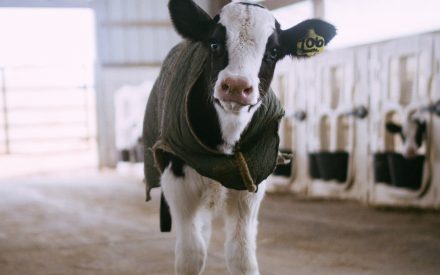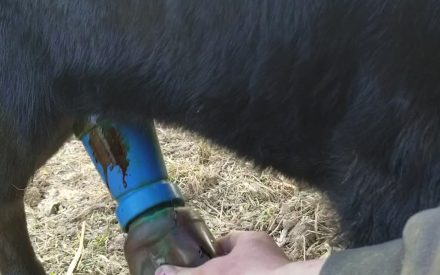Preconditioning dairy-beef calves for success as beef
Various marketing opportunities exist for dairies to market dairy-beef cross calves including selling them ‘wet’ (i.e., preweaned, younger than 8 weeks of age). Dairies may retain ownership, marketing preconditioned or backgrounded feeder calves at approximately 400 or 700 lbs. Dairies may also finish beef cross cattle.
Let’s take a minute to define marketing opportunity. Opportunity means options, and each option has its own potential financial return. There is the adage “don’t be a price taker,” and to avoid that passivity is to become an active marketer by adding value to calves, and actively searching out potential buyers who will provide a positive rate of return on calf inputs.
Beef cross calves will be on the grill less than 22 months after birth. One or two treatments for respiratory symptoms early in a young calf’s life often causes reduced lung capacity, which raises susceptibility to respiratory disease later in life. In the feed lot, this leads to poor weight gain and reduced carcass quality grades. Marketing wet dairy-beef cross calves with some guarantee of future health and growth performance is an opportunity that no dairies should ignore.
The term ‘preconditioning’ refers to beef terminology used for weaned calves that are 5 to 7 months old. The goals of a preconditioning program are to utilize available resources to efficiently and cost-effectively increase the value of weaned calves and decrease the costs associated with calf illness. When implemented successfully, cattle buyers spend fewer resources treating sick cattle, sale barns provide healthier calves that, in turn, attract new buyers, and sellers often receive market incentives that compensate for vaccine costs.1
Beef preconditioning programs include holding calves on the origin farm for 45 to 60 days after weaning to make sure they are bunk broke and eating well prior to shipping. How can wet-beef cross calves be preconditioned to succeed under the care of the next buyer? When dairies decide to retain ownership of beef cross calves, what preconditioning tasks should be implemented?
The next buyer of your beef cross calf wants to know: What are they? What is their health status?
The ‘what’ involves sharing the calf’s dam and sire history. Calves will not have increased value when using random beef bulls. Breed with beef sires that complement the dam’s potential for marketable meat.
Market the wet calf’s health status by sharing evidence of passive transfer of colostrum and share the dam’s vaccination protocol. The calf received colostrum; therefore, the calf should have maternal antibody to the agents covered by the dry cow or close-up heifer vaccine protocol that includes scour-prevention vaccines. Also share the herd prevention strategies for Bovine Viral Diarrhea Virus (BVD) and digital dermatitis (DD, hairy heel wart). Calves raised for beef must be castrated and disbudded prior to weaning.
Preconditioning tasks adapted for dairies
Calves leaving the dairy must have dry navels with no evidence of navel infection. They must be ambulatory and eating well (as evidenced by an increase from their birthweight). Calves over 1 week of age better fit this description.
Use caution with antibiotic residues from dry cow treatments or other cow therapies when feeding colostrum and transition milk. Wisconsin has a robust bob veal market. Err on the side of safety and assume every calf leaving the farm may be slaughtered for human consumption tomorrow.
Use a portable calf scale to measure the calf’s weight before colostrum feeding to determine colostrum and subsequent feeding accuracy.2 Validate weekly colostrum management by taking total protein (TP) or Brix measurements of all calves greater than 1 day but fewer than 7 days of age.3 Market calves with documentation of passive transfer.
Calves may successfully respond to oral scour vaccines and intranasal respiratory viral vaccines given at birth; however, prevention from infectious scour and respiratory agents for calves younger than 4 months of age is best provided by passive transfer of colostrum. Market wet calves with documentation of the newborn vaccines administered.
Calves should double their birthweight by day 56 at 8 weeks of age, which translates into an average daily gain (ADG) of 1.5 lbs.3 Weigh calves prior to transport and market those that have gained weight since their birthday. Retain those that haven’t, and work to identify and correct the reasons why calves are not gaining weight.
Penn State Extension determined that Holstein heifer calves should grow in height by 4 to 5 inches by weaning. For dairies retaining ownership, measure the beef cross calf’s hip height as soon as it is standing using a frame score measuring stick. Tracking the animal’s growth (weight and height) allows for accurately feeding them to reach their potential stature. Measure weight (and calculate ADG) and height at weaning and continue to track weight (ADG) at subsequent pen or ration changes for example at 400 lbs. or 700 lbs.
BVD is a major risk to calf health and persistently infected (BVD-PI) calves must be identified and euthanized.4 BVD-PI test all newborn calves—ear notches are easy to do and submit in weekly batches, with lab results returned within 24 hours.5 Only market calves that test negative for BVD-PI.
Calves become exposed to DD in the maternity pen from infected cows. Work with your veterinarian to develop DD biosecurity protocols. When retaining ownership, inspect calf hooves at weaning and 4 to 5 months of age, and routinely inspect finishing cattle and promptly treat for DD.
Cattle with horns and bulls pose serious safety risks for personnel and other cattle. Some beef sires are not polled, so purposefully inspect beef cross calves for horn buds and disbud using pain mitigation as close to their day of birth as possible. Calves should not be transported with non-healed head wounds.
Do not castrate bull calves just prior to transport; the castration-wound risk to overall health is too great. Knife-cut castrate bulls prior to weaning using pain mitigation, and the wound must be healed prior to transport.
The calf’s respiratory viral and bacterial vaccinations should be completed at approximately 400 to 500 lbs. A ‘simpler’ beef vaccination protocol is needed than that used for replacement heifers as there is no need to
prime reproductive immunity for calves that are destined for harvest between 16 to 20 months of age.
Beef vaccination protocols focus on preventing bovine respiratory disease (BRD) due to viruses including Infectious Bovine Rhinotracheitis (IBR), Parainfluenza Influenza (PI3), Bovine Respiratory Syncytial Virus (BRSV) and Bovine Viral Diarrhea (BVD); and bacteria including Mannheimia haemolytica (previously Pasteurella haemolytica), Histophilus somni, and Mycoplasma bovis6,7. Protocols also include vaccines to prevent over-eating disease caused by Clostridia.
Work with a beef nutritionist and the calf’s phenotype to balance the calf’s ration from 400 to 700 lbs., and onto finishing. Your veterinarian and beef nutritionist can help designate the administration of Clostridia vaccines prior to nutritional step-ups and/or implanting.
Calves leaving for the feedlot at either 400 or 700 lbs. should be vaccinated per label with boosters completed 2 weeks prior to transport with, at minimum, an IBR/PI3/BRSV/BVD-modified live virus and Manheimia haemolytica and Clostridia vaccines. Work with the next owner to identify preferred vaccine products.
Citations
- Ward, H., Powell, J., & Gadberry, S. Livestock Health Series Preconditioning Programs for Beef Calves. Division of Agriculture, Research & Extension, University Arkansas System. https://www.uaex.uada.edu/publications/pdf/FSA-3074.pdf
- Calf Track: Calf Management Training System. © The Pennsylvania State University, 2006. https://extension.psu.edu/calftrack-calf-management-system
- Economics and Effects of Accelerated Calf Growth Programs. Pennsylvania State University Extension. https://extension.psu.edu/economics-and-effects-of-accelerated-calf-growth-programs
- DCHA Gold Standards 2016. https://www.ag.k-state.edu/outreach/ffa/DCHA%20Gold%20Standards%202016.pdf
- Wisconsin Veterinary Diagnostic Laboratory (WVDL). Test and Fees. https://www.wvdl.wisc.edu/index.php/about-wvdl/
- Ellis, J. Update on viral pathogenesis in BRD. 2009. Animal Health Research Reviews 10(2): 149–153. doi:10.1017S14662520999020X
- Griffin, D., et al. Bacterial pathogens of the Bovine Respiratory Disease Complex. 2010. Vet Clin Food Animal 26: 381–394. doi: 10.1016/j.cvfa.2010.04.004
Download Article

 NSAID use around calving
NSAID use around calving ▶️ Watch: Cows need fiber too! Storage and feeding tips to minimize nutrient losses
▶️ Watch: Cows need fiber too! Storage and feeding tips to minimize nutrient losses Navel Care for Beef x Dairy Calves
Navel Care for Beef x Dairy Calves ▶️ Watch: Prácticas de manejo para mejorar la calidad del forraje
▶️ Watch: Prácticas de manejo para mejorar la calidad del forraje


